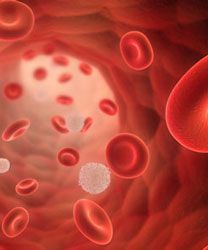Article
Early Administration of Cytarabine May Improve Survival in Pediatric ML-DS
Author(s):
Administering high-dose cytarabine to children with myeloid leukemia of Down syndrome during the second chemotherapy induction cycle resulted in improved event-free survival and overall survival compared to results observed in previous research studies.
mcl

Administering high-dose cytarabine to children with myeloid leukemia of Down syndrome (ML-DS) during the second chemotherapy induction cycle resulted in improved event-free survival (EFS) and overall survival (OS) compared to results observed in previous research studies.
In the COG AAMO0431 trial, researchers with the Children’s Oncology Group (COG) administered cytarabine at the second induction cycle instead of the intensification cycle. Study results showed that earlier administration was associated with a 5-year EFS of 89.9% (95% CI, 84.8-93.4) and a 5-year OS of 93.0% (95% CI, 88.5-95.8), both rates representing an improvement over previous COG research in this patient population.
In COG AAMO0431, researchers used the treatment schema from the prior COG A2971 trial with 3 major modifications:
- High-dose cytarabine with asparaginase was administered in induction II instead of intensification, thus replacing 1 of 4 cycles of continuous-infusion cytarabine and daunorubicin and reducing the cumulative daunorubicin dose by 25%.
- Intensification cycles with moderate-dose cytarabine and etoposide were administered instead of high dose cytarabine.
- The number of prophylactic intrathecal doses was reduced from 7 to 2.
The goal of COG AAMO0431 was to answer 2 primary questions: 1) If administered in the second induction cycle rather than the intensification cycle, could high-dose cytarabine improve disease-free survival (DFS) and 2) Could a 25% lower cumulative dose of daunorubicin reduce the risk of adverse cardiac events without compromising outcomes?
From March 2007 to December 2011, eligible pediatric patients enrolled in COG AAMO0431. There were 144 patients in the cohort diagnosed with acute myeloid leukemia (AML) and 60 diagnosed with myelodysplastic syndrome (MDS). Most (97.1%) were treatment-naïve and the median age from diagnosis was 1.59 years. Ninety patients (44%) had congenital heart defects, but no patient had CNS involvement with leukemia at diagnosis.
Patients underwent 4 cycles of induction therapy and 2 cycles of intensification therapy. Prophylactic intrathecal cytarabine was administered at diagnosis/start of induction I and at induction III. Induction cycles I, III, and IV consisted of continuous-infusion cytarabine at 6.7 mg/kg per day for 96 hours, continuous-infusion daunorubicin at 0.67 mg/kg per 24 hours for 96 hours, and oral 6-thioguanine at 1.65 mg/kg twice daily for 4 days.
Induction cycle II consisted of cytarabine at 100 mg/kg administered as a 3-hour infusion every 12 hours for 4 doses on days 1 and 2, and repeated on days 8 and 9 for a total of 8 doses with E. coli asparaginase (200 U/kg) being administered intramuscularly 3 hours following the last dose of cytarabine on days 2 and 9.
Intensification cycles I and II consisted of continuous-infusion cytarabine 3.3 mg/kg per 24 hours for 7 days (168 hours) and etoposide 4.2 mg/kg per dose administered as a 1-hour infusion for 3 days.
The total cumulative chemotherapy dose was 27,800 mg/m2 for cytarabine, 240 mg/m2 for daunorubicin, and 750 mg/m2 for etoposide. Total cumulative chemotherapy dose was 1600 mg/m2 for cytarabine and 160 mg/m2 for daunorubicin in COG A2971.
For patients with AML, EFS was 88.6% (95% CI, 82.0%-92.8%) and OS was 92.2% (95% CI, 86.4%-95.6%). For patients with MDS, 5-year EFS was 93.2% (95% CI, 82.9%- 97.4%) and OS was 94.9% (95% CI, 85.1%-98.3%).
The 5-year cumulative incidence of relapse for patients with AML was 10.0% (95% CI, 5.7%-15.7%) and for MDS was 5.1% (95% CI, 1.3%-12.9%).
Researchers had access to minimal residual disease (MRD) data from day 28 after induction I for 146 patients (71.6%). Twenty-one patients (14.4%) were positive for MRD (>0.01%). Five-year DFS was significantly worse in these patients (76.2%; 95% CI, 51.9%-89.3%) compared with those with no detectable MRD (92.7%; 95% CI, 86.3%-96.1%; P = .011). Five-year OS was also significantly worse for MRD-positive patients than MRD-negative patients. Of the 5 patients whose MRD levels were 0.01% to 0.1%, 2 relapsed, 1 chose to leave the study, and 2 remained in remission.
MRD positivity was significantly higher in male patients than in female patients (P <.001) and in those with isolated trisomies other than trisomy 8 (P = .05). There was no significant difference in MRD status based on race/ethnicity, classification of MDS or AML, or history of TMD. Only MRD on day 28 after induction I was significantly correlated with DFS in both univariate and multivariate analyses.
Induction II, when patients were being treated with high-dose cytarabine, accounted for the greatest number of adverse events (AEs). Researchers observed 27.1% of all AEs during that cycle—66% of those were grade ≥3 and 7.9% were classified as grade 4. Induction II was also associated with the longest median time to absolute neutrophil count recovery (>1000/µL) with a median of 37 days and a maximum length of 67 days. The second longest recovery period occurred during intensification I with a median of 33 days and a maximum length of 54 days.
Patients were most likely to be treated in the intensive care unit during induction I (6.9%) and induction II (7%).
Grade ≥3 febrile neutropenia was the most common AE and was most frequent in induction II (29.7%) and induction I (27%). Grade ≥3 sterile-site bacterial infection occurred in 22.6% and 19.1% of patients in induction II and induction I, respectively.
Researchers observed 7 grade ≥3 cardiac-related AEs, but no deaths occurred.
Taub JW, Berman JN, Hitzler JK, et al. Improved outcomes for myeloid leukemia of Down syndrome: a report from the Children's Oncology Group AAML0431 trial. Blood. 2017;129(25):3304-3313. doi: 10.1182/blood-2017-01-764324.






%20(2)%201-Recovered-Recovered-Recovered-Recovered-Recovered.jpg?fit=crop&auto=format)

%20(2)%201-Recovered-Recovered-Recovered-Recovered-Recovered.jpg?fit=crop&auto=format)
%20(2)%201-Recovered-Recovered-Recovered-Recovered-Recovered.jpg?fit=crop&auto=format)